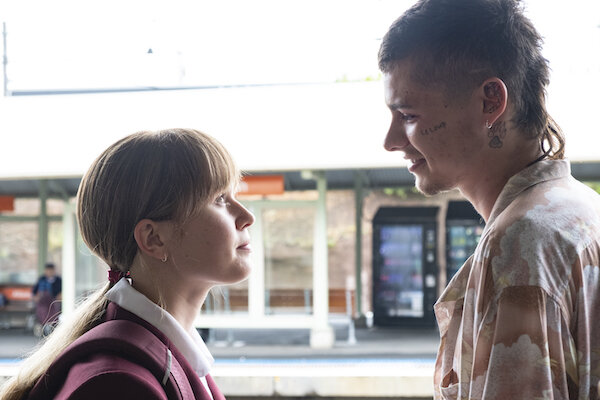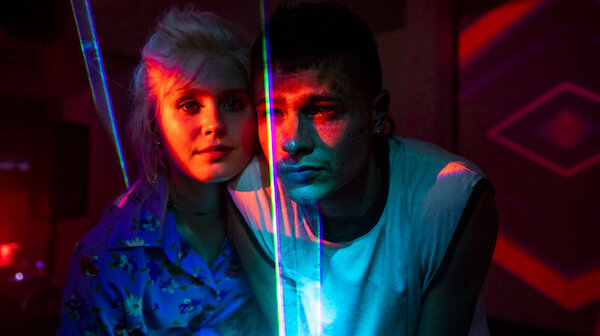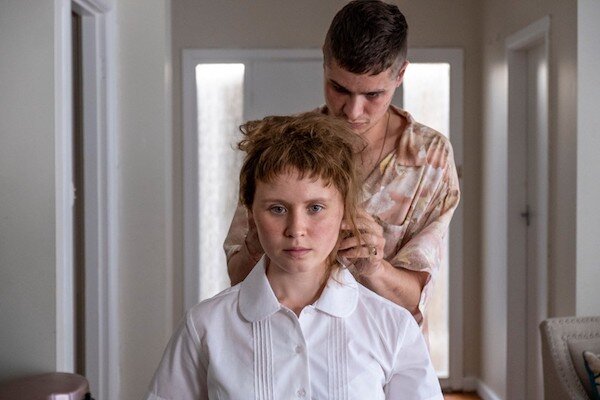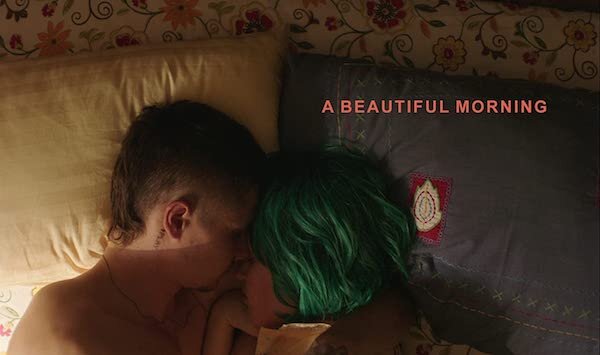A coming-of-age film that hurtles fast towards the end of a life, Shannon Murphy’s debut feature is unconventional from the beginning – a fairytale flipped on its head that wrestles with life, love, death and transformation without missing a beat. Understanding metamorphosis and the promise of self-affirmation found in romance, Savina Petkova explores the singularity of Babyteeth.
“I think something in you has changed”, a poignant remark made by a violin tutor reflects the simple truth of the main character in Shannon Murphy’s feature debut Babyteeth, a teenage girl who is falling in love for the first time. Halfway through the film, it becomes evident that Milla has affirmed herself: embracing the spontaneity of giving your heart up to a stranger, and the liberation that comes with it, reflected in both visual and aural transformations. Babyteeth’s emotionally charged storytelling leads its terminally ill protagonist along her journey to an unconventionally happy ending, and does so with attentiveness and genuine care. In her committed adaptation of Rita Kalnejais’s play, Murphy guides audiences through a fairy-tale narrative structure, while constantly rearranging its building blocks along the way. Even if an ending retroactively determines the story, as life sometimes seems like a series of recognisable steps to a rehearsed dance, reinventing oneself always involves side-stepping the well-trodden path, some off-beat swaying, with a lover’s chest to bump yours into.
According to fairy-tale scholar Marina Warner, it’s metamorphosis that lies at the heart of the tradition, even more than any magical presence, happy ending, or moral function. Cinema, already a space for wonder amidst the everyday, makes use of this capacity to transfigure characters metaphorically more often than physically. However, it’s important to state that bodily and psychic transformations, within folklore and literary tradition, only reinforce the permanence of identity – forms may be altered but in the process of change, there is a certain yearning for stability – to be, to reveal who you already are. Physical metamorphosis, as depicted in fairy tales, usually intervenes in place of flight, as a punishment, or as a means of escape to a desired life (take, for example, The Little Mermaid). In Babyteeth, Milla’s transformation is gradual rather than abrupt, and involves a manifestation of her blooming vitality in the wake of advancing cancer, that also serves as an act of resistance to time expiring and oblivion. The film unfolds at a meticulous pace, its rhythm not unlike a cardiogram with its spikes and flatter lines distributed throughout its two-hour runtime. Many individual sequences echo that same cascade of emotions, bookended by piercing visuals and their corresponding effects, an optimal example being the film’s opening, titled ‘When Milla Met Moses on Platform 4’.
Isolating Milla’s concerned face and her wandering green eyes in a close-up, the trembling camera is immediately closer to her than any other person. In this first scene, layered teenage talks suck in the background noise and Milla’s deep breaths resonate within her own claustrophobia. The audience, then, comes closer to a cryptic and well-guarded world, as the image of a schoolgirl’s back and her tightly-knotted ponytail swoons in and out of focus, in a hesitant, shaky pause. In the rapid cut that switches back for frontal perspective, a hard-hitting blurry figure thrusts itself in front of Milla, and judging by the grand entrance, this will be someone important. Standing in front of the platform, train speeding in, a young man (also introduced from the back) raises his tattooed arms in a defenceless manner – yet he does not withdraw from the platform. The swish of air, the shocked bystanders, and his absent-minded smile contribute to the aura of enchantment around this mysterious young man. Moses, with his gold chain hanging freely from the unbuttoned shirt, his knuckles red with bruises, and his bloodshot eyes, is already framed as exceptional, in contrast with Milla’s strict, polished look. A classic meeting of opposites, with the dangerous male counterpart as it exists in folklore and legends. Be it as an ogre, a demon lover, or Bluebeard. Babyteeth sets on fire an intense and fleeting relationship that, on the one hand, taps into the perfect-timing trope of a fairy tale meeting, and on the other, pushes against the long tradition of pre-planned, predestined, and sought-out happy ending. The one suggesting that if it’s not happy, it’s not the end.
As much as hair and make up transform Toby Wallace (from his conventionally attractive, good-rather-than-bad boy look) to embody a ruffled outcast as Moses, his magnetism inspires a transformatory effect on Milla. His influence, rather than her metamorphosis as a result of their encounter, becomes the subject of conversations – even though Milla’s father Henry is a psychotherapist and her mother Anna is always eloquently concerned about communication. This is when cinematic means come into place to compliment the dialogue’s purposefully left blind spots. By telling the story of a psychological shift in an exteriorised manner, through body language and costume design, Murphy orchestrates Milla’s image around the (new) appearance of certain feminine attributes (short skirts, long satin dresses, or make up, specifically lipstick). Their performative use signals a shift towards the young woman’s desire to be looked at, as in the story of Cinderella, altered looks seem to provide the means to be noticed. At the same time, such a transformation of redressing acquires another, more harrowing layer, when related to Milla’s own ‘ticking clock’ – different to the way Cinderella’s curfew looms, a clunky metaphor for her terminal diagnosis.
There is, in fact, a ball for this princess to attend too. The end of year school formal functions as an idea more in Anna’s imagination, as she envisions her daughter having a ‘normal’ life, but the event only exists in Milla’s mind as a couple’s activity for Moses and her. Their unlikely relationship (considering he repeatedly abandons her, and suffers from an addiction to prescription drugs) departs from any beauty-and-the-beast type of canon. Crucially, Milla does not attempt to change Moses in any morally didactic kind of way, but her presence affects him as a reflecting mirror could (remember The Beast’s looking glass?), while Moses’ own familial troubles feed more and more humanity into his character. But, in another halt and twist to the fairy tale narrative, Babyteeth repositions its ‘fancy-dress ball’ event as an unexpected house party – much sooner than the viewer learns that Milla’s health will prevent her from attending the actual prom.
With a dizzy montage of touching, caressing, and timid looks, the couple takes a train into the city and the whole sequence is drenched in shadows, illuminated by street and neon lights, which bounce off colourful clothing, including matching purple shirts. A pharmacy and then a dimly-lit sidewalk stand in for a spotlit dance floor, as Milla dances to her own rhythm and the camera freely follows her moves, aligning with Moses’ admiring gaze. Suggested voyeurism is made obvious, and the traditionally objectifying male gaze is traded for a rediscovering one. Milla is now seen as she wants to be seen – as the effervescent woman she already is, rather than devitalised from her illness – and that in itself is transformatory. But when Moses’ attention wavers, she shares a dance with an unknown woman, whose smoky eyes, shaven head, and tight silver tank top (signifiers of both androgyny and femininity) mesmerise Milla, reminiscent of her own cancer hair loss. They then dance and mirror one another, stars and galaxies projected upon their bodies, while the whole scene pulsates with experimental folk music. An initiation of sorts happens while Moses is away, but crucially, it happens only after an affectionate exchange between the two has facilitated Milla’s confidence.
This psychological shift is also visually translated through Milla’s appearance. While sucking on an ice lolly, she skilfully applies lipstick with just one hand and no mirror. The word, ‘pretty’, itself, is a compliment that in its typical use gestures towards a decorative look, oftentimes non-threatening in a sexual manner. But when Moses calls Milla ‘(very) pretty’, it opens up space for her grasp on femininity that is not attributed to the exchange of lustful looks. The visual aspects of Milla’s transformation can be traced throughout the film as a move from skin to surface, or more particularly, from hair to wigs.
Right after the train platform meet-cute, Milla gets Moses to cut her long, tamed hair. Such an act of rebellion, against the doll-like aesthetic her mother tends to promote, conceals a bolder claim for further transformation. By leaving her look in the hands of a stranger (and apparently a razor made for grooming poodles), Milla already negotiates her rite of passage, submitting herself before she can regain control of her body. More specifically, she presents her exterior self through the wigs she chooses to wear, be it the playful electric blue short one, or a more conventionally styled blonde cancer wig. Babyteeth is not a film about surfaces and appearances, but it constantly evokes depth through aesthetic means – the soaring camera and its lack of focus over bodies and clothes; the canonical Mozart pieces performed on violin and piano to the upbeat extra-diegetic soundtrack, such as the soothing sway of “Come Meh Way” by Sudan Archives. Shedding metaphorical skin here invites the question of psychological stakes beyond the metamorphosis’s decorum and performative functions. As a cancer patient, Milla is somehow reliant on wigs to keep up appearances to conceal vulnerability from the outside world, but the film makes it obvious that she claims her looks for herself, and does so in relation to the love story unfolding. As if Cinderella decided to disregard the ticking clock, and solidify her beautified transformation forever.
Milla’s transformation may be articulated through her appearance as in a classic fairytale plot, but what happens if the body fails to support it? By the end of the film, when hope is shrinking at an unnerving pace, she bemoans, “This body is too much”, signalling the tragedy of an impossible superimposition of her strong drive for living and her withering body. Corporeal weakness and strength of will compose the film’s contradictory tone, one of playful sorrow. As a tonal plunge lays the groundwork for a crushing narrative arch, the film still doesn’t end.
Babyteeth’s sleeping beauty awakens not as a result of Prince Charming’s embrace, but she rises up to ardently kiss him instead. As throughout the rest of the film, no sexual energy is persistently stirred, the scene rather emanates intimacy and tactile vulnerability, as the camera frames neck to neck, chin in chin, swinging back and forth in a tight frame. A sex scene full of longing and haptic details, caresses, and soft kisses, makes another fairy tale subversion out of Milla’s reclaimed happy ending – while of course, a typical fairy tale never mentions sex overtly. Nodding to the film’s title, a material incarnation of the whimsical atmosphere is presented when Milla’s baby tooth – an atypical condition at her age – finally falls out. Signalling her coming of age and also hinting her life’s end, this shortening of a life thread comes as a tragic blow while retaining its humorous potential. By uncovering the intimacy between tragedy and light-heartedness, Babyteeth never sugar coats the definitive fact of loss, grief, and despair. But as with every fairytale, it makes a promise through the metamorphic potential of love that actually unties one’s identity, rather than constructing it through universal tropes. To make up one singular ‘happily ever after’.
Savina Petkova (@savinapetkova) is a film critic/PhD candidate based in London who lives from one film festival to another. She specialises in animal representations in contemporary film and writes for Electric Ghost Magazine and MUBI Notebook.






